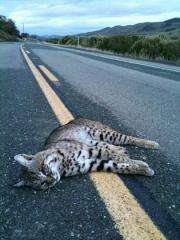Roadkill studies on the rise

(PhysOrg.com) -- Roadkill is the stuff of jokes and sometimes supper. But wild animals hit by vehicles are a serious concern of some ecologists, including UC Davis researcher Fraser Shilling, who just completed the first year of the largest-ever citizen-science survey of roadkill.
"Thousands of animals are killed on California’s roads every day, including endangered species. This is a threat to the state’s natural legacy and, for some species, their very existence," said Shilling, a staff research associate and co-director of the UC Davis Road Ecology Center.
To collect data that could help transportation planners and conservation managers design more wildlife-friendly roads, Shilling and colleagues created a website where anyone can quickly record roadkill observations.
Now Shilling has released the first year of data for the California Roadkill Observation System and launched a similar effort for the state of Maine with Maine Audubon.
The first year of reporting for California includes 6,700 roadkill observations by 300 people involving 205 animal species from acorn woodpeckers to zebratail lizards. The most common roadkill victim: raccoons. The most active roadkill reporters: UC Davis alumni Ron Ringen, a retired veterinarian, and his wife, Sara, a retired family nurse practitioner. They have logged more than 1,000 records.
Ron Ringen started counting roadkill animals for Shilling's study as he drove from Davis to fishing spots near Marysville. "I have always had a great curiosity about wildlife," he said. "Now I have the time to do something of value with it."
Eventually his wife, "who thought I was crazy," decided to join the effort. A few times each month, they spend about three hours driving 100-mile-loops. Sara Ringen records GPS locations of each find while her husband identifies the animal, photographs it and removes the carcass from the road.
They recently set a one-day personal record: 127 animals, including birds from 17 species.
In the near future, Shilling hopes to expand the project to include focused studies on particular types of roads, roadkill website development in other states, and analyses of the causes of wildlife-vehicle collisions. The work to date has been done on a shoestring: Shilling and his colleagues have donated about $20,000 worth of time to the California website. They are using university computing and Web resources. Maine Audubon is funding the cost of the Maine website.
The UC Davis roadkill research is a joint effort of two university programs, the Road Ecology Center and the Information Center for the Environment.
The Road Ecology Center aims to improve transportation systems by better understanding the impact of roads on natural ecosystems and human communities. It is a program of the UC Davis John Muir Institute of the Environment.
Provided by UC Davis
















